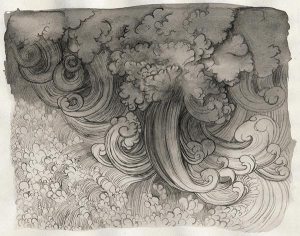
A while back I had posted this chart on a forum in response to a question about what these blue paints looked like compared to each other. The color isn’t 100% accurate but it’s close enough to show how they compare. The box on the right shows color averaging from the first 1:1 mix with white for each paint for comparison.
Ultramarine
This is a workhorse paint. It’s a very good, strong, easy to use, and useful color that’s reliable to not fade. Every brand of paint sells this and it’s always one of the least expensive from any of them. It’s hard to find a more perfect paint. Almost every paint set for students includes this. For most artists that I’ve seen, if they only have one blue on their palette, it’s usually this one. This is sometimes referred to as “synthetic ultramarine” while talking about lapis lazuli, which is natural ultramarine.
Lapis Lazuli
Natural ultramarine is the opposite of synthetic ultramarine in almost every way. It’s weak, dull, very expensive, only available from a few brands, and difficult to use in many painting styles because it’s so transparent and so easily overpowered by anything you mix into it. You can see this from how light it becomes when mixed with the same amount of white as any of the other paints on the chart were. It’s good for glazing because of its high transparency, and in watercolor it’s actually useful for its high granulating texture. Other than that I think a lot of artists tend to have high expectations for this famous paint that’s spoken of so highly in much of art history but when they actually try it themselves the paint doesn’t match the hype. There’s different grades of pigment depending on the purity and to make this from the highest purity would be extremely expensive. I think it’d be better to just use synthetic ultramarine.
Indigo
Natural indigo is known to fade and I don’t think anyone makes paint with it anymore. Synthetic indigo is PB66, only used by a few brands, and I’ve read conflicting reports about its lightfastness. Almost all paints named “indigo” today are just mixes of blue and black, sometimes including other pigments such as a little violet, with each brand using their own mix. The synthetic indigo in this comparison is very slightly bluer and less grey than the mix below it (which is made from phthalo blue, lamp black, and ultramarine), but if you wanted the mix to be bluer it would be easy enough to just add a small amount of extra blue to it. Doing this would avoid any question of whether synthetic indigo is actually lightfast and you wouldn’t be confined to just the few brands that make it. If you want to use a so-called “Zorn palette” (usually yellow ochre, vermilion or light cadmium red, ivory black, and white) you could consider indigo instead of pure black to give the palette a little more flexibility. Greens would be slightly easier to mix and the cool greys would be a little more believable as “blue” when placed next to a bright red than simply mixing black with white.
Anthraquinone, Indanthrone, or Indanthrene Blue
The name depends on the brand, but I call it indanthrone. The popularity of this slightly reddish blue seems much lower than many of the others because I rarely see it on anyone’s palette. I think it’s usually somewhere in the middle of a brand’s price range and is clearly not as intensely chromatic as ultramarine. It has much more tinting strength than ultramarine though, so a smaller amount of this paint will go further in mixes, possibly offsetting the price. It also seems a little more opaque than most blue pigments. I used to use this a lot early on when I started painting and was exploring different pigments, but I haven’t used any for a long time now. Maybe that’ll change.

Every brand of paint sells this and it’s one of the least inexpensive from any of them.
I think you meant to say it is the most inexpensive.
k.
Sent from Windows Mail
Yes, thanks. Sometimes I edit a sentence too many times and forget to change the grammar of one part after changing the wording of another part. 🙂
Interesting. Learned something new, again!
Thanks 🙂
I’ve been meaning to post more color charts like this for a very long time. Maybe I’ll finally get around to making one on yellow ochre at some point.
Very interesting and informative! Thank you- please do more of these.
In body color and tinting, the closest to Ultramarine seems to be Indanthrone; I also like the name, for some reason I can’t determine…
It is a good name. I think maybe some appeal is just because it’s somewhat unique. Sure, it has the word blue as part of the name, but it’s still more than just a simple descriptive word such as sky or navy combined with a basic color name. 🙂
I made my own color charts. That way I there is no alteration based on the computer monitor, and I can see how they act in different light.
That’s a good idea. It’s always a challenge trying to photograph and edit the colors as well as I can, but some things are simply out of my control and the only real way to know for sure is to see them in person. 🙂